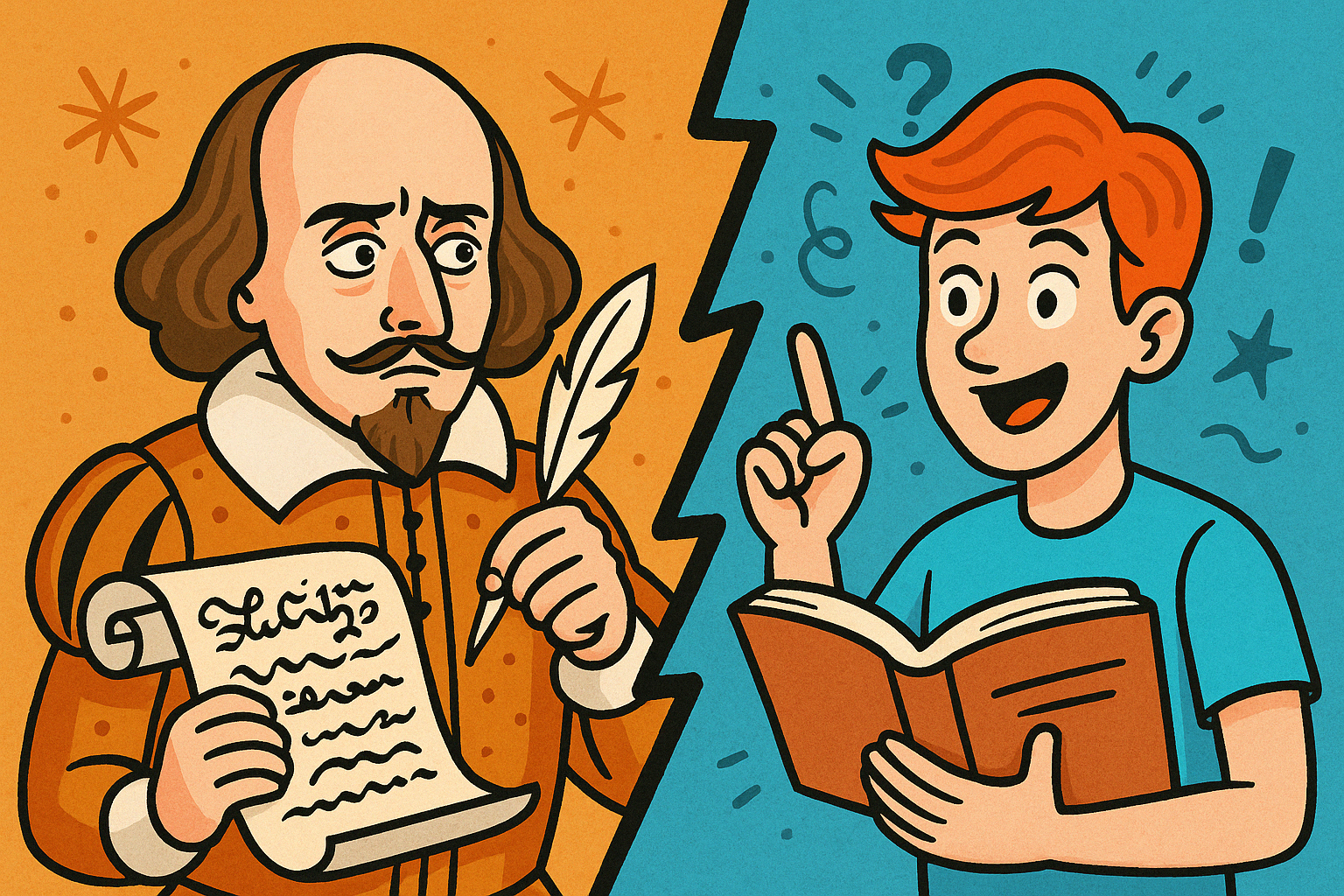The Challenges Of Putting Shakespeare’s Old English Into Modern Language

Let’s clear this up right away: Shakespeare didn’t write in Old English. That’s the stuff of Beowulf, not Hamlet.
What we’re dealing with is Early Modern English, which—while technically closer to our modern usage—is still packed with weird syntax, dense poetic devices, and loads of words that either don’t exist anymore or now mean something totally different.
When I started digging into how people translate or adapt Shakespeare’s language today, I expected the usual “make it more accessible” angle. But the deeper I went, the more I realized: this is a linguistic minefield.
Every single word carries layers of rhythm, rhetoric, and cultural subtext. And experts don’t always agree on how much of that you can mess with before you’ve changed the play itself.
So, in this post, I want to unpack the main challenges of updating Shakespeare’s language—and why it’s a lot trickier than it looks.
Linguistic Complexity and Stylistic Density
Alright, here’s where things get really layered. If you’ve spent any time working with Shakespeare’s texts—editing them, performing them, teaching them—you already know: his language is rhetorically dense and rhythmically charged.
But what’s fascinating is how tightly those two things are woven together—and how hard it is to modernize one without breaking the other.
Take the syntax. Shakespeare loved inversion. You’ll find lines like “What light through yonder window breaks?”—which, in modern syntax, is basically “What’s that light in the window?” Sure, we can modernize it, but we lose the poetic lift, the breathy rhythm that mimics Romeo’s awe.
And let’s not forget: the line is in iambic pentameter.
You mess with the word order, and suddenly the meter’s gone.
Meter matters more than most people realize. It’s not just a technical feature—it’s part of the meaning.
A perfect example is Macbeth’s “Is this a dagger which I see before me.” The regular iambic pentameter gives way to broken rhythms as Macbeth unravels.
You modernize it to something like “Am I really seeing a knife?” and you’ve flattened the psychological texture and the musicality.
Then there’s the vocabulary. Some words Shakespeare used are “false friends”—they still exist, but their meanings have drifted.
A fun one is “wanton.” Today, it sounds almost exclusively sexual. But back then, it could mean playful, unrestrained, even luxurious.
So when Helena in A Midsummer Night’s Dream says “You draw me, you hard-hearted adamant,” and someone modernizes it to “You attract me like a magnet,” that’s technically accurate—but adamant also connoted emotional stubbornness and mythic strength. You lose richness for the sake of clarity.
And then, of course, there are the puns. Shakespeare was obsessed with double (and triple) meanings.
Like Mercutio’s “Ask for me tomorrow, and you shall find me a grave man.” Try modernizing that. “I’ll be dead tomorrow” just… doesn’t cut it. You lose the bitter wit. You lose Mercutio.
What really struck me is this: Shakespeare didn’t just write what his characters said. He wrote how they thought.
Their language follows their emotions, their status, their mental unraveling.
Updating the words without breaking that rhythm or register is incredibly difficult.
So yeah—modernizing Shakespeare’s language?
It’s not just about translation. It’s a balancing act between clarity, fidelity, and musicality.
And more often than not, you have to choose two out of three.
Cultural and Contextual Translation
Alright, so we’ve tackled the nuts and bolts of Shakespeare’s language—the syntax, meter, wordplay.
But here’s the thing: language never exists in a vacuum. Every single line in Shakespeare’s work is soaked in the cultural and historical context of Elizabethan England.
And once you start modernizing the words, you’re inevitably forced to decide how much of that context comes along for the ride.
Let’s break down some of the biggest headaches this causes:
1. Anachronism Risk
One of the most tempting traps when modernizing Shakespeare is slipping into modern idioms or references that don’t belong.
Imagine changing Juliet’s line “Parting is such sweet sorrow” to “Breaking up is hard to do.” Sure, it’s clear.
Maybe even cute.
But it yanks the reader out of the play’s world and drops them somewhere between a Neil Sedaka lyric and a therapy session.
Even seemingly harmless updates—like swapping “thou” for “you”—can introduce tonal dissonance. Modern English is flatter, less layered in tone. “Thou” implies closeness, hierarchy, even contempt depending on context.
Replacing it risks flattening out entire dynamics between characters.
Bottom line: anachronisms mess with immersion, and in a Shakespeare play, that immersion is fragile already.
2. Idiomatic Expressions
Elizabethan idioms are weird. Let’s just admit it. And many of them don’t survive translation.
Take the phrase “to wear one’s heart upon one’s sleeve” from Othello. It’s still in use today, but what if it wasn’t?
Would we say “I’m being emotionally vulnerable” instead? It gets the point across, sure—but it lacks the physical metaphor, the exposed imagery that adds emotional depth.
Some idioms, like “hoist with his own petard” (from Hamlet), make no sense to modern ears without explanation.
A petard was an explosive device. Being hoisted by one? That’s blowing yourself up with your own bomb—essentially being undone by your own plans. A modern update might say, “he got caught in his own trap,” but that’s bland by comparison.
And when idioms have to be paraphrased, you often lose brevity, rhythm, and impact all at once.
3. Social Hierarchies and Honorifics
Shakespeare’s use of address—like “sirrah,” “thou,” “my lord,” or “good morrow”—isn’t just decorative. It’s deeply tied to social relationships.
When someone switches from “you” to “thou,” or from “sir” to “boy,” it usually signals a shift in status, power, or intimacy. Take King Lear, who begins by calling Cordelia “my joy” and ends up screaming “you unnatural hags” at his daughters.
The choice of words tracks his psychological collapse and the breakdown of familial order.
Modern English doesn’t really have this nuance.
Our pronouns and titles are more democratic (which is great in real life—but less so for drama). When editors update these lines, they’re forced to find other ways to signal status shifts, often through stage direction or tone—not the language itself.
It’s like trying to paint a landscape with only three colors instead of twenty.
4. Religious and Mythological References
Elizabethan audiences were steeped in both Christian doctrine and classical mythology. When Shakespeare compares Cleopatra to Isis, or references Cain and Abel, his audience instantly got it.
Modern audiences?
Not always.
Those references can fly right over people’s heads—or worse, confuse the tone completely. In Measure for Measure, Angelo’s inner turmoil is wrapped in religious guilt. When you simplify that language to make it more accessible, the heavy moral tension can evaporate.
Now, you can add a footnote. Or include a short program note in performance. But that changes the experience. It turns the play into a sort of museum exhibit—educational, but detached.
And adapting those references with modern equivalents (say, swapping the Greek gods for Marvel characters—yes, I’ve seen this attempted) risks sliding into parody.
5. Political Subtext
Here’s one people often miss: Shakespeare was playing a dangerous game politically. Many of his plays, especially the histories and tragedies, are laced with veiled critiques of power structures—but they’re subtle enough to avoid censorship (most of the time).
For example, Richard II was staged shortly before the Essex Rebellion, and Queen Elizabeth reportedly said, “I am Richard II, know ye not that?” That line, “the king is but a man,” has enormous political weight in context.
Modernizing it to something like “He’s just a guy like the rest of us” might technically work, but it erases the careful threading of monarchy, divine right, and human fallibility that made the original so dangerous—and brilliant.
And so we’re left with a dilemma: how do you preserve subtext that only exists within a specific cultural and historical lens? That’s not just a linguistic issue. It’s philosophical.
Interpretive Authority and Artistic License
So now we’re deep into the weeds: if we know that modernizing Shakespeare’s language compromises rhythm, idiom, culture, and political nuance… why do we keep doing it? And more importantly—who gets to decide how far is too far?
This is where the debate really gets heated.
Fidelity vs. Accessibility
Some editors, directors, and translators are die-hard purists. They argue that the text is the text, and if an audience doesn’t understand it, they should work harder—or educators should step up.
On the other end, you’ve got accessibility advocates who say: if people can’t understand a word, they’re not connecting with the story.
And if they’re not connecting, then what’s the point of preserving the original words?
I get both sides. But I think the problem is that we often frame this as a binary choice. In reality, most modern adaptations exist on a spectrum, constantly negotiating which layers to preserve and which to bend.
Who Has the Authority to Modernize?
Let’s talk about power for a second—because modernizing Shakespeare is an act of interpretation, and interpretation is never neutral.
When a translator chooses to simplify Lady Macbeth’s “unsex me here,” are they softening her rage?
When a director updates Prospero’s magic to “technology,” are they shifting the play’s colonial subtext?
It’s not just language choices—it’s thematic framing. And it raises a big question: who gets to shape how Shakespeare “sounds” to modern ears? Is it the literary editor? The classroom teacher? The artistic director at a regional theatre?
This matters, especially when you consider how Shakespeare is taught globally, across cultures and languages. A “modern” English adaptation in Mumbai or Tokyo might read very differently than one in London or New York.
Academic Resistance vs. Artistic Reimagination
In academic circles, there’s still a lot of resistance to full modernization—especially of the “No Fear Shakespeare” variety. It’s often seen as dumbing down or even vandalizing the original.
But in the theater world?
Things are looser.
I’ve seen Julius Caesar as a modern-day political rally, Taming of the Shrew reimagined through feminist critique, and Much Ado set at a 1970s disco. And honestly? A lot of it works.
These reimaginings don’t always rely on full textual modernization—but they do show that language is only one tool. Meaning also comes from performance, design, music, gesture. And sometimes, letting go of perfect fidelity allows for new kinds of insight.
The Global Shakespeare Question
Finally, let’s zoom out. Modern English isn’t even the only language people are reading or performing Shakespeare in. He’s been translated into over 100 languages—often with wild, brilliant liberties taken.
In Japan, Macbeth was famously reinterpreted as Throne of Blood, with samurai and ghost forests. In South Africa, The Tempest has been retold as a story of apartheid and reconciliation. These aren’t just cultural reinterpretations—they’re full-on transformations.
So when we talk about modernizing Shakespeare’s English, we’re not just talking about language.
We’re talking about ownership.
And what it means to make these plays matter today, in different voices, different rhythms, different worlds.
Final Thoughts
So yeah—putting Shakespeare into modern language?
It’s not just “updating the words.” It’s a tightrope walk between clarity and complexity, rhythm and readability, past and present. And there’s no one right answer.
But honestly, that’s what makes it so interesting. Every modernization—whether it’s a full rewrite or just a slight tweak—reveals something. About language, about culture, and about us.
If you’ve ever tried to rewrite a single line of Shakespeare and felt like you were wrestling with a ghost—trust me, you’re not alone.
It’s supposed to be hard.
That’s the point.





